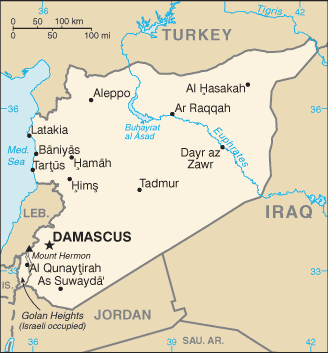There was some bluster on Monday in response to reports that the Syrian regime of Bashar al-Assad made the first step in weaponizing chemical stockpiles and also has moved them around to different locations in the country.
 In terms of US action, the conflict in Syria has long been defined by the high rate of Islamic jihadists in the ranks of the rebel forces and by the lack of feasible military options for regime change at the disposal of the Obama administration. So, the US has said that the “red line” which would precipitate an American military intervention is if Assad uses chemical warfare on his own population.
In terms of US action, the conflict in Syria has long been defined by the high rate of Islamic jihadists in the ranks of the rebel forces and by the lack of feasible military options for regime change at the disposal of the Obama administration. So, the US has said that the “red line” which would precipitate an American military intervention is if Assad uses chemical warfare on his own population.
So, apparently eyes have been kept on Assad’s chemical stockpiles. Danger Room reported the following exclusive:
Engineers working for the Assad regime in Syria have begun combining the two chemical precursors needed to weaponize sarin gas, an American official with knowledge of the situation tells Danger Room. International observers are now more worried than they’ve even [sic] been that the Damascus government could use its nerve agent stockpile to slaughter its own people.
The U.S. doesn’t know why the Syrian military made the move, which began in the middle of last week and is taking place in central Syria. Nor are they sure why the Assad government is transferring some weapons to different locations within the country, as the New York Times reported on Monday.
Whenever journalists report anonymous officials making claims that bolster the case for war, heavy scrutiny is in order. This official told Danger Room that “isopropanol, popularly known as rubbing alcohol, and methylphosphonyl difluoride” had been combined by Syrian engineers, which is the first step to weaponizing sarin gas. “They didn’t do it on the whole arsenal, just a modest quantity,” the official said. “We’re not sure what’s the intent.”
Even if the information is true, which is by no means a given, it’s not reasonable to assume the Assad regime is preparing to unleash chemical warfare on his people. The Obama administration has made it clear such action is a “red line” and even if Assad recognizes this as rhetoric issued for the deterrence factor (which it transparently is) it’s probably enough to disincentivize him from taking such action, if he were ever so inclined in the first place. Assad has been employing incredible force to quell this rebellion because it aims to eliminate him and his regime. The only thing worrying the Assad regime more than the rebellion is the prospect of some kind of US-led bombing campaign or invasion, which could undoubtedly topple the regime but would then lead to such destruction and chaos that the country would be ruined and a lengthy occupation and counter-insurgency effort would inevitably follow, à la Iraq. So Assad isn’t about to attract that sort of attention.
Additionally, for what its worth, Russia has guaranteed Assad’s restraint on chemical weapons use. That’s not a pledge one of the the five most powerful nations in the world makes lightly.
If I were to speculate, again, assuming the reports are true, Assad could be making such moves in order to deter international action against his regime. One of the primary reasons cited in Washington officialdom against initiating a no-fly zone or a bombing campaign in Syria is the fact that Assad’s anti-aircraft capabilities and chemical stockpiles are located in residential areas. This means any attempt to destroy them would put vast numbers of civilian lives at risk, making the humanitarian situation in the country far worse than it is currently, and thus defeating the pretext for intervention. Assad knows this has been an argument against military action, and his alleged moderate moves to make his chemical stockpiles more dangerous and to transfer them to different locations in the country could be playing on this factor.
It’s also true that, as much as the US has been trying to undermine the Assad regime by supporting the jihadist rebels, Washington prefers the chemical stockpiles be under the control of the Assad regime rather than the rag tag rebel opposition. Take Michael Eisenstadt at the perpetually pro-war Washington Institute for Near East Policy, who notes that given the lack of feasible military options, “the preferred means of dealing with the problem of Syrian CW [chemical weapons] are deterrence, assistance, containment, and elimination.” Here’s his explanation of “assistance”:
To deal with the threat of diversion, the United States should quietly work with Russia, building on their history of cooperation on a variety of threat-reduction initiatives in order to offer Syria various means of maintaining accountability and control over its CW stockpile. While the United States does not have an interest in strengthening Assad, it does have an interest in the regime retaining control over its CW for as long as it is around (just as the United States offered the Soviet Union technology to help secure its nuclear arsenal during the Cold War, to avoid accidental or unauthorized use).
US military officials have been quick to point out the costs of war in Syria and the White House has consistently said that direct military intervention “would lead to greater chaos, greater carnage.” I don’t see them changing their tune any time soon, nor do I see the Assad regime using chemical weapons. The real concern is the proxy war being waged by the Obama administration which continues to bolster a dangerous band of criminal religious extremists. Not only is this morally and legally problematic, but it is laying the groundwork for further blowback.

